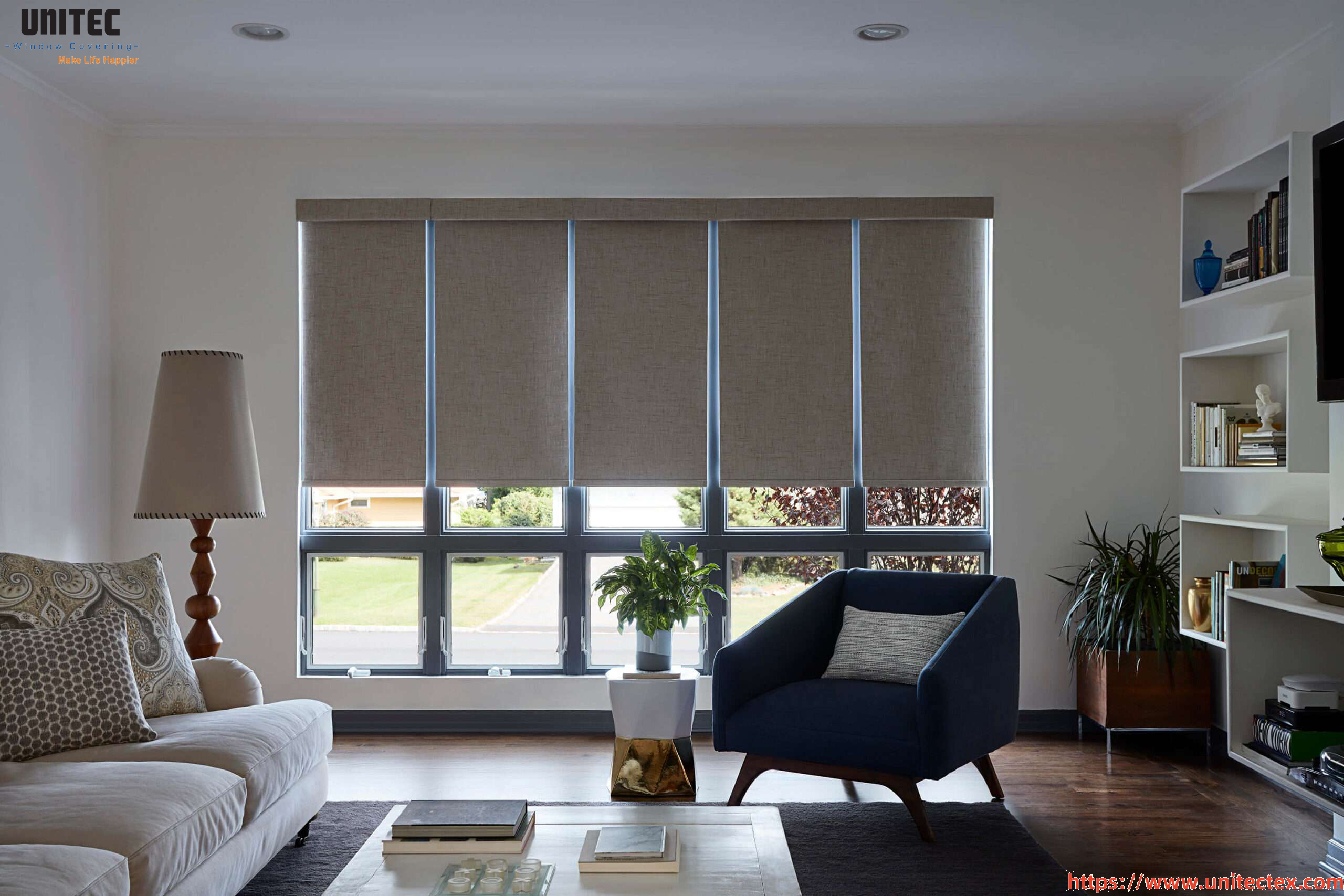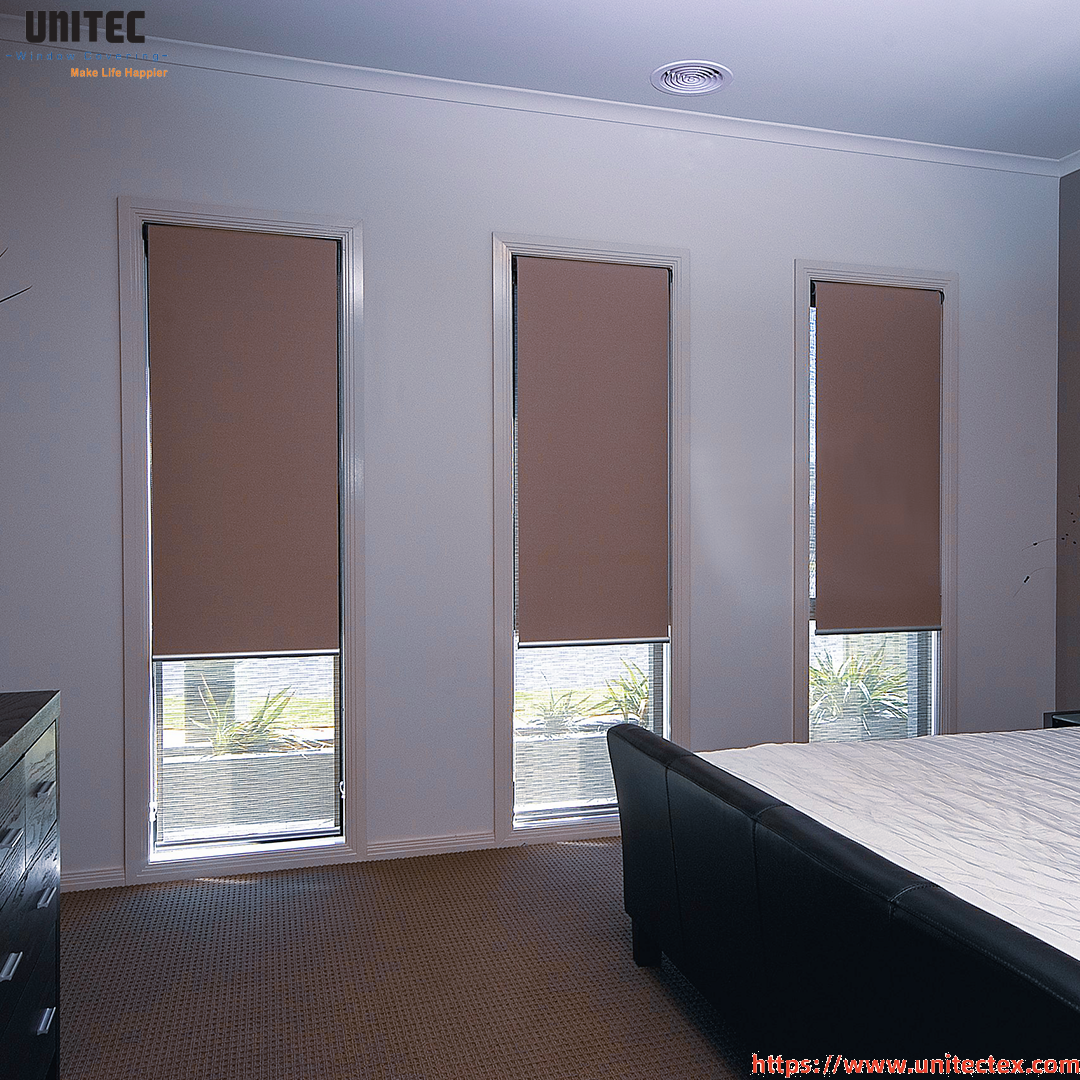1. Material Science: The Foundation of Performance
The performance of customizable roller blinds starts with the materials used. Various types of fabrics and coatings determine how well the blinds function in terms of light control, heat insulation, and UV protection.
a. Light Control and Fabric Composition
One of the key features of roller blinds is their ability to control the amount of light entering a room. The fabric material plays a critical role in this function. Fabrics used in roller blinds are typically made from woven polyester, cotton, or blended synthetic fibers, often combined with coatings to improve their performance.
-
Blackout Fabrics: These are made from densely woven fibers or contain a special blackout coating that prevents any light from passing through. Blackout roller blinds are often lined with a layer of polyurethane or PVC to block light completely. The science behind this is simple: the thicker and denser the fabric, the less light can penetrate.
-
Light-Filtering Fabrics: These fabrics allow a controlled amount of light to pass through, making them ideal for spaces that require soft lighting without the harshness of direct sunlight. The fabric composition includes woven polyester threads that create tiny gaps for diffused light to filter through. These materials also often feature a light-reflective backing, which helps reduce glare while maintaining privacy.
b. UV Protection
UV protection is another important aspect of roller blind materials. Prolonged exposure to ultraviolet (UV) rays can cause fading in furniture, flooring, and artwork. Some customizable roller blinds are equipped with UV-blocking coatings that absorb or reflect UV rays. This is typically achieved through chemical treatments or the use of specialized coatings such as titanium dioxide (TiO2), which has been proven to have excellent UV-blocking properties.
2. Thermal Insulation: A Key to Energy Efficiency
Another critical scientific function of customizable roller blinds is thermal insulation. In energy-efficient window treatments, the goal is to maintain a comfortable indoor temperature by reducing heat transfer between the inside and outside of the building. Roller blinds, especially those made from thermal fabrics or with insulating coatings, contribute significantly to energy savings.
a. Heat Reflection and Absorption
Thermal fabrics often incorporate materials such as polyester with reflective coatings (e.g., aluminized polyester or metallic foil) to reflect solar heat away from the building. The reflective coating essentially works like a mirror, bouncing back infrared radiation that would otherwise enter through the window and raise the indoor temperature.
b. Heat Retention in Winter
In the colder months, customizable roller blinds with insulating properties help prevent heat loss. The principle here is thermal resistance. Blinds made from multiple layers of fabric or those with an insulating core, such as foam-backed fabrics, create a barrier that reduces heat transfer through the window. This helps retain heat inside the home, decreasing the need for artificial heating and ultimately saving on energy bills.

3. Motorization and Smart Technology: The Future of Customization
Advances in technology have allowed for the development of motorized and smart customizable roller blinds. These innovations not only improve convenience but also contribute to energy savings and comfort by optimizing blind operation.
a. Automated Control Systems
Motorized roller blinds are equipped with electric motors that allow for easy operation, often through remote control, smartphone apps, or even voice assistants like Google Home and Amazon Alexa. The operation of motorized blinds can be synchronized with smart home systems that adjust the blinds based on various factors, such as time of day, temperature, or the intensity of sunlight.
-
Scientific Principle: The integration of sensors (light, temperature, motion) enables automatic adjustments of the blinds. For instance, blinds can be set to lower during peak sunlight hours to prevent overheating and raise when the sun moves to ensure natural lighting. This dynamic control system enhances the efficiency of climate control within the home, optimizing energy use.
b. Power Efficiency
One of the scientific innovations in motorized blinds is the solar-powered motor, which uses photovoltaic (PV) technology to harness solar energy to operate the blinds. This is particularly useful in homes looking to further reduce their environmental footprint and reliance on electricity.
4. Sound Insulation: Acoustic Benefits of Roller Blinds

Another often-overlooked benefit of customizable roller blinds is their ability to reduce noise transmission. In cities or noisy environments, external noise can disrupt daily life, making noise control an important factor for comfort.
a. Acoustic Properties of Roller Blinds
Certain fabrics, particularly thick, multi-layered materials, provide sound insulation properties. When sound waves hit the surface of these blinds, they are absorbed and diffused, rather than reflected back into the room. This is known as sound absorption. The thicker and denser the material, the better the blinds will absorb sound, thereby reducing the amount of noise entering from the outside.
-
Acoustic Science: This principle is similar to how soundproofing materials like foam or mass-loaded vinyl work in building construction. By using specific fabric structures and coatings, customizable roller blinds can enhance the acoustics of a room and provide a quieter environment.
5. Customization: A Scientific Approach to Design and Functionality
The beauty of customizable roller blinds lies in their ability to be tailored to individual needs. This is achieved by adjusting the size, fabric, color, and operational mechanism to suit the unique requirements of the space.
a. Size and Fit: Precision Engineering
Custom roller blinds are manufactured based on exact measurements of windows. This precision ensures that the blinds fit perfectly, with no gaps that could compromise performance. Advanced measuring techniques and CAD (Computer-Aided Design) software are used to ensure accurate dimensions and flawless fitting.
b. Mechanisms and Features
Customizable roller blinds can be equipped with different mechanisms, such as chain-operated, spring-loaded, or motorized systems. The choice of mechanism affects not only the ease of use but also the durability and safety of the product. For instance, motorized systems may require specific electrical configurations, while spring-loaded mechanisms need to account for tension and balance.

For more information about curtains, please follow us and contact us
Post time: Nov-10-2025




